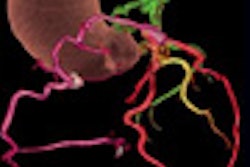CHICAGO - A new method for viewing virtual colonoscopy computer-aided detection (CAD) results may be more efficient than traditional sequential browsing of CAD hits, according to a pilot study presented at the 2007 RSNA meeting.
"'Patch view' may offer improvements in the time to (identifying) the first true-positive (CAD result)," said Padma Sundaram, Ph.D., of Stanford University in Stanford, CA. She presented the research in a scientific session on Thursday.
The Stanford researchers sought to find a better way of incorporating CAD output into radiologists' reading of virtual colonoscopy (VC) studies. The traditional method of reviewing CAD output sequentially in the order suggested by the algorithm suffers from a number of drawbacks, Sundaram said.
For example, CAD markings are not perfect, and true-positive detections are not always found at the top of the list. In addition, the list only provided coordinates of locations that may contain polyps, and radiologists can't quickly reject obvious false positives due to the lack of visual cues. As a result, this may increase the radiologist's time to the first true positive, she said.
In a different approach, the institution's Smoothed Shape Operators (SSO) algorithm outputs surface "patches" of interest instead of voxel locations. All of the CAD output is viewable in a single display, similar to viewing images in a thumbnail mode, Sundaram said. Readers can review the CAD output in any order, allowing them to quickly scan and reject obvious false positives.
The researchers tested the method on 32 supine VC cases containing total of 32 polyps larger than 6 mm. The SSO algorithm was run on each case, with the top 24 CAD results output in a 4 x 6 grid. These patch views were then presented to four radiologists, who were asked to indicate their top three choices of what they'd like to explore further.
On average, 71% of the top three choices contained a true-positive finding. The first true positive was reached with an average of 1.4 false-positive selections, compared with 4.9 false positives for sequential reading. The mean review time for this process was one minute per case for all readers.
Sundaram acknowledged several limitations in the study, including the recording of findings only when patches demanded further investigation. In addition, the researchers did not record the final decisions by the radiologist, and the radiologists may have erroneously rejected a true positive, she said.
Nonetheless, the patch view approach may offer improvements in the time to the first true positive result, and yields concurrent display of CAD output, Sundaram said. Users can also freely explore the CAD results.
"Since this is a low-prevalence setting, I think it's very important to account for the imperfection of algorithms," she said, and try to compensate for the imperfections by efficiently integrating the CAD results into the reading process.
By Erik L. Ridley
AuntMinnie.com staff writer
November 29, 2007
Related Reading
VC CAD beats human readers in multicenter trial data, November 19, 2007
Polyp ranking scheme boosts CAD efficiency, October 1, 2007
Fully automated VC CAD system solves tagging problems, June 25, 2007
VC CAD ramps up detection of medium-sized polyps, March 12, 2007
CAD will be key to VC screening, September 13, 2006
Copyright © 2007 AuntMinnie.com





















